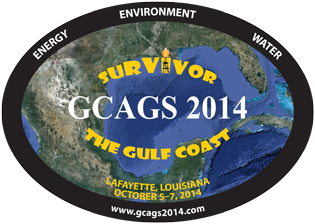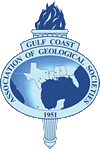1:00 pm–4:50 pm • Monday, Oct. 6 • Moderated by Mary Broussard and Bill Finley
(Sponsored by Freeport McMoRan Oil & Gas)
Location: Blues Room
In what may be a first-of-a-kind forum for the GCAGS Convention, GCAGS President Mary Broussard has gathered an outstanding panel of 4 leading experts on the geology and geophysics of the Gulf of Mexico, including: Carl Fiduk, GCSSEPM President; Ernie Mancini, University of Alabama Emeritus Professor; Roger Slatt, University of Oklahoma Professor; and Fred Hilterman, Geokinetics Chief Scientist. Four presentations will be given on topics that should be of interest to anyone who works Exploration or Development projects in the Gulf of Mexico – or anywhere else. It matters not if you are a student, brand new to the industry, or a 30+ year veteran. There will be lessons to be learned for all attendees.
Moderated by Mary and Technical Program Chairman Bill Finley, the symposium is designed to be given as four (4) separate talks, each followed by a brief period of Q&A. Judging from the titles, this should be an informative and lively forum with something for everyone. We hope you can join the forum in its entirety, or – at the very least – stop by to hear about a specific topic of interest.
“Tectonics and Depositional Episodes of the Northern Gulf of Mexico:
A Brief History and Petroleum Geology”
Dr. J. Carl Fiduk, Chief Geologist, Schlumberger
Summary: This lecture will attempt to summarize the critical factors which have influenced the formation and evolution of the Gulf of Mexico. It will cover the basin’s physiography and tectonic origin as a result of crustal extension during the early Mesozoic breakup of Pangaea. It will address the great importance of the Louann evaporite deposit. Deformation and movement of the Louann salt affects almost all the overlying strata and plays a very important role in all aspects of the basin’s petroleum systems. It will discuss the importance of paleolatitude, climate, and tectonic development as related to depositional systems and sediment accumulation. The five depositional megasequences each have unique characteristics that contribute to making the Gulf of Mexico a world class petroleum province.
|
 |
Biography: Carl holds a B.S. and M.S. degree in Geology from the University of Florida, an M.B.A. degree from the University of Texas of the Permian Basin, and a Ph.D. in Geology and Geophysics from the University of Texas at Austin. Having held multiple positions in the oil industry, the Federal Government, and Academia, Carl is currently Chief Geologist for WesternGeco in Houston, Texas. His research interests cover clastic deposition, salt structural deformation and evolution, basin analysis, shelf margin to deep marine depositional processes, marine sedimentology, petroleum systems analysis, and the use of three-dimensional seismic data in petroleum exploration. Current research interests include salt-sediment interaction, fluvial deltaic deposition in the Cretaceous Seaway of NW Colorado, and deep marine stratigraphic analysis in the Gulf of Mexico. Carl teaches internal training classes on seismic interpretation and salt tectonics for WesternGeco and external industry courses for Nautilus U.S.A. and local geologic societies. |
| Carl is an AAPG Certified Petroleum Geologist, and holds membership the Houston Geological and Geophysical Societies, the Society of Exploration Geophysicists, the Society for Sedimentary Geology, and in is a member of the Gulf Coast Section SEPM where he is the current President. Carl has published over 70 peer-reviewed abstracts and papers. |
“Turbidite Petroleum Geology in the Deepwater/Subsalt Gulf of Mexico”
Dr. Roger M. Slatt, Gungoll Family Chair Professor, University of Oklahoma
Summary: It has been over 10 years since discovery of large Gulf of Mexio deepwater/subsalt discoveries such as Mars-Ursa, Thunder Horse, Tahiti, Mad Dog, and Cascade. Exploration and drilling activity have now returned to pre-Macondo Tragedy (2010) levels—under more stringent regulations—and new discoveries are being made at regular time intervals. Giant, Middle-Lower Miocene fields such as Tahiti, Mad Dog, and Thunder Horse are entering their peak plateau production. Large and older Upper Miocene and Pliocene fields such as Auger, Conger, and Mars-Ursa are being rejuvenated by secondary and enhanced recovery. Paleogene fields such as Jack and Cascade-Chinook are in their early stages of development. Appraisal activities for deeper targets in existing big fields are also common, adding tremendous upside potential for current big fields (e.g., Cardamom Deep, Mad Dog Deep, and Mars-Ursa discoveries). Technologies are keeping pace with exploration and drilling to deeper depths and further offshore. These submarine fan reservoirs have many features in common, but usually with some differences. (Summary coauthored with Fuge Zou.)
|
 |
Biography: Roger M. Slatt currently holds the Gungoll Family Chair Professor in Petroleum Geology and Geophysics at the University of Oklahoma and is Director of the Institute of Reservoir Characterization in the Sarkeys Energy Center at OU. Previously he worked at Memorial University of Newfoundland, Arizona State University, Cities Service Research, ARCO, and the Colorado School of Mines. He has published over 100 papers and abstracts, and made numerous presentations on the subjects of petroleum and reservoir geology, seismic and sequence stratigraphy, shallow marine and turbidite depositional systems, geology of shale, glacial and Pleistocene-Quaternary geology, and geochemical exploration. He has received numerous awards, including AAPG Distinguished Service Award, AAPG Honorary Membership, AAPG Grover Murray Distinguished Educator Award, and SEG Special Commendation Award. |
“Characteristics of Carbonate Rocks: Examples from the Northern Gulf of Mexico”
Dr. Ernest A. Mancini, Professor Emeritus, Department of Geological Sciences, University of Alabama
Summary: This lecture focuses on the sedimentary and stratigraphic characteristics of carbonate rocks in the northern Gulf of Mexico. Emphasis is placed on carbonate depositional models, systems and associated potential reservoir facies. The anatomy of carbonate reservoirs is examined from thin sections, cores, well logs, and outcrops. The effects depositional conditions and diagenetic processes have on reservoir quality and productivity are reviewed. The lecture concludes with discussion about exploration and development strategies for carbonate reservoirs.
|
 |
Biography: Ernest A. Mancini is Professor Emeritus in geological sciences in the areas of petroleum geology and stratigraphy in the Department of Geological Sciences, the University of Alabama. He is the founding director of the Center for Sedimentary Basin Studies and of the Eastern Gulf Region of the Petroleum Technology Transfer Council at the University of Alabama. Mancini is the first director for the Berg-Hughes Center for Petroleum and Sedimentary Systems at Texas A&M University. He served as State Geologist of Alabama and director of the Geological Survey of Alabama and as Oil and Gas Supervisor of Alabama and director of the State Oil and Gas Board of Alabama. |
“Seismic Attribute Analysis of the Gulf of Mexico”
Dr. Fred Hilterman, Chief Scientist, Geokinetics, Inc.
Summary: The fluid factor (ΔF), Poisson impedance (PI), and lambda-rho (λρ) are three seismic attributes commonly used to predict pore fluid and lithology. The pore-fluid sensitivity of these attributes was evaluated with both well-log and seismic data in Tertiary unconsolidated sediments from the Gulf of Mexico. While the sensitivity of one attribute versus another to discriminate pore fluid is often debated, the sensitivity of the three attributes are not independent but can be traced back to the fluid factor. The three attributes along with their statistical distributions for different pore fluids were measured in 183 reservoirs and then used to quantify the seismic amplitude in a 3D survey to “true” reflectivity values thus allowing pore-fluid classification. (Summary coauthored with Fuge Zou.)
|
 |
Biography: Dr. Fred Hilterman started his career with Mobil in the field. Upon receiving his Ph.D. from Colorado School of Mines (CSM), he rejoined Mobil and then left for the University of Houston (UH) in 1973, where he co-founded the Seismic Acoustics Laboratory (SAL). Later, along with two associates, Fred co-founded Geophysical Development Corporation (GDC), which offered innovative services integrating log and seismic data. After the acquisition of GDC by Geokinetics, he tagged along where he works today as Chief Scientist. He has enjoyed recognition by his peers with awards that include the Virgil Kauffman Gold Medal, the Maurice Ewing Medal, Honorary Membership from SEG, and the Distinguished Alumni Medal from CSM. He has been a continuing education instructor for SEG and AAPG since 1976, and was selected by the SEG to be the 2001 Distinguished Instructor. Fred is also a Distinguished Research Professor at UH and will be the first to say that among all his accomplishments, he most enjoys teaching geophysics to those with a hunger for learning. |
|








